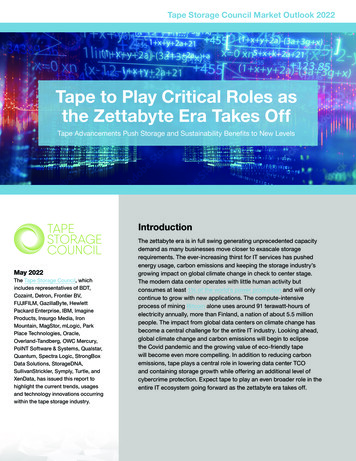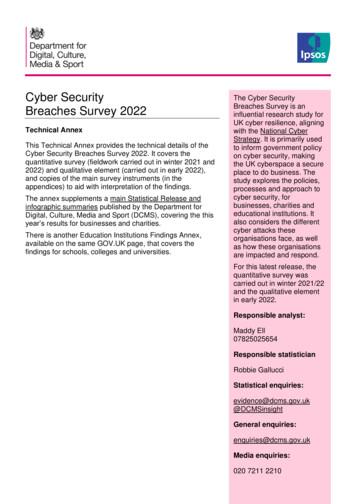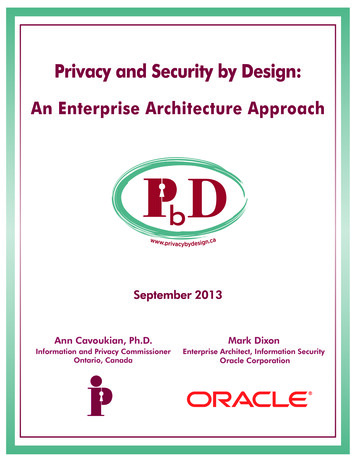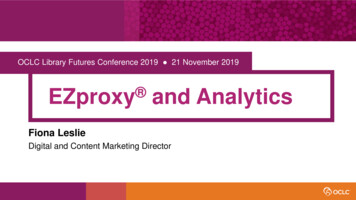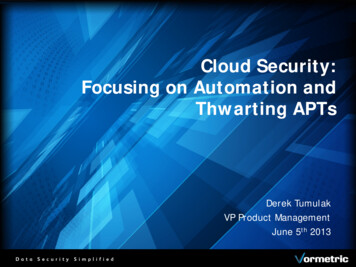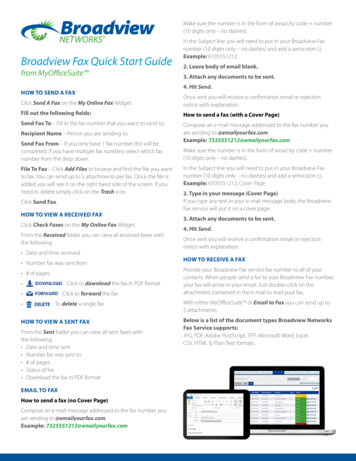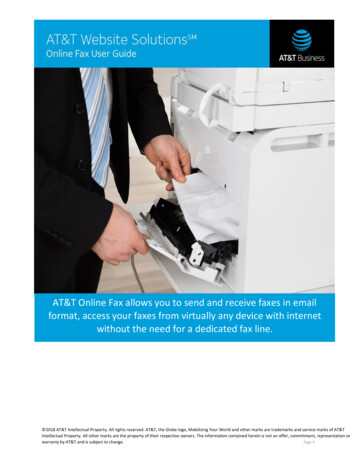
Transcription
WHITE PAPERSecurity in fax: Minimizingbreaches and compliance risksMaintaining regulatory compliance is a major business issuefacing organizations around the world. The need to secure,track, and store information for compliance purposes is criticalbecause the risks of noncompliance are real. Now more thanever, there is pressure to closely manage fax communications anddocument processes. It’s not surprising that organizations areturning to enterprise digital fax technology to support compliancerequirements. This white paper addresses fax communications andthe steps you can take to help keep your organization compliant.
ContentsIntroduction3Fax security and corporate compliance3Actively addressing fax security5Using fax to ensure data privacy7Fax solutions for supporting compliance8Conclusion9About OpenText9Security in fax: Minimizing breaches and compliance risks2/9
IntroductionConstantly evolving government regulations and standards are impacting howbusinesses around the world secure and manage information. Information isubiquitous—whether paper-based or digital—and the requirements for effectivelysecuring, maintaining, exchanging, and auditing information for compliance canbe complex.Simply stated, government regulations requiring organizations to conform to certainpolicies, specifications, standards, or laws are raising the stakes on fax security.Therefore, many organizations are turning to enterprise-grade, digital fax solutionsto help address information exchange policies and procedures and to meetcompliance requirements.Fax security and corporate complianceCompliance regulations aboundRegulatory compliance is a business fact of life, with new government regulationsand standards introduced all the time. The impact of regulatory change is a globalphenomenon as organizations are required to conform to new mandates takingeffect in every region. Industries most affected include financial services (banks,non-bank mortgage lenders, loan brokers, financial or investment advisers, debtcollectors, tax return preparers, insurance, and real estate settlement serviceproviders), healthcare, legal, and government.The landscape is one of constantly changing compliance requirements. Corporateethics violations and scandals have resulted in tighter legislative regulations in theUnited States, such as Sarbanes-Oxley. Privacy concerns are addressed by theHealth Insurance Portability and Accountability Act (HIPAA), as well as theGramm-Leach-Bliley Act. European legislation has resulted in considerableregulations, including the Data Protection Act 1998 and the Freedom of InformationAct 2000 enacted in the UK. Even private entities are instituting their own modesof compliance, such as the Payment Card Industry Security Council’s Data SecurityStandard (PCI-DSS). These various regulations require businesses to constantlyevaluate their security and privacy protocols and understand how those protocolscould potentially expose them to compliance risk.Fax, as a method of secure information exchange, continues to persist aroundthe globe and across all industries. Faxing remains the most trusted form ofsecurely exchanging information because the communication protocol itself isinherently secure, requiring peer-to-peer direct connectivity prior to transmissionof data. Therefore, a document doesn’t get transmitted unless the outbound faxtransmission has a secure and direct connection with the receiving fax device.Since faxing is easier to use than other secure exchange technologies which requireencryption keys, passwords, portal or other clunky methods of access, faxing iswidely adopted.As businesses strive to go paperless and drive toward digital transformation,it's imperative that their commonly used technology, including fax, transformsalso. Eliminating the risk of paper-based faxing is an important step in security,compliance, and digital transformation. Digital fax technology enables paperless,secure information exchange.Fax is widely used in a number of industries to protect content privacy, maintaincompliance, and decrease the risk of a breach.Security in fax: Minimizing breaches and compliance risks3/9
HealthcareFax remains the standard method of communicating protected health information(PHI) for healthcare organizations to maintain compliance with HIPAA. Patientinformation must be exchanged securely. Paper-based faxing with standalone faxmachines puts a healthcare organization at risk if the device is not secured in alocation accessed only by authorized individuals.Digital faxing eliminates the risk of paper-based faxing with standalone faxmachines and the unintentional exposure of PHI. Digital fax solutions exchangecontent electronically and deliver the content directly to its intended recipient.Recipients most commonly access the content at their computer, within anapplication or secured network folder. This helps eliminate the risk of unintentionalexposure and keeps content private to only those with access.Digital fax solutions also typically integrate with electronic medical records (EMRs),making it easy to upload or deliver PHI from the application. This eases the burdenof manually shuffling paper documents, scanning, and processing paperwork.Digital fax also helps minimize the risk of lost or misplaced fax content.FinanceFinancial services organizations depend on fax to support several businessprocesses, which are highly regulated and require secure and trusted forms ofcommunication. Financial institutions use fax to comply with regulations suchas Sarbanes-Oxley and Gramm-Leach-Bliley. With transaction transparency,irrefutable audit trails, and the ability to transmit original signatures, banks, lenders,and creditors use fax to process credit applications, trade confirmations, claimforms, and collection notices.Communications are often time-sensitive for both the financial institution and thecustomer. Financial agencies leverage digital fax technology to provide secureinformation exchange, along with the means to increase communication speed,improve cycle times, reduce costs, and improve customer satisfaction.GovernmentGovernment agencies tend to be highly risk-averse, and faxing remains thecommunication method that keeps content secure and decreases the risk ofinterception and hacking. However, with the known inefficiencies of paper-basedfaxing with standalone fax machines, there is an opportunity for these agenciesto implement a digital fax solution that meets strict security requirements whileimproving information exchange. Government agencies should seek digital faxsolutions that are Joint Interoperability Test Command (JITC) certified to implementwithin their organization.LegalLegal firms throughout the world use fax daily to send and receive confidentialdocuments with clients, attorneys, and the courts. The legal industry—both lawfirms and in-house counsel—need a cost-effective and secure way to deploy faxcommunications and increase the efficiency and productivity of their staff.Document retention and retrieval for effective e-discovery is also a challengewith traditional faxing methods. With digital fax, law firms have full visibility of faxcontent, as well as who sent it and when, and who received it and when—and evenwho viewed it and when. A complete audit trail is perhaps most important andhas proven most effective in legal scenarios when proof of delivery and receipt ofcontent can be established and proven. In addition to proper authentication, firmscan easily build fax into document management strategies for the timely retrieval ofinformation needed in e-discovery and auditingSecurity in fax: Minimizing breaches and compliance risks4/9
Actively addressing fax securityBecause of compliance risks, enterprises heavily reliant upon fax must takeinitiative and remain steadfast when investigating the privacy and security oftheir transmitted and archived fax data. Faxes typically contain highly sensitiveinformation about business transactions and decisions. Management thereforeneeds to actively promote programs for ongoing risk assessment to make surethat procedures and product standards to keep their fax data secure are beingaddressed.To determine if your organization is on the right track, start by answeringthese questions: Do you have control over the security of your incoming faxes? Do you know exactly where your fax documents are being delivered—andto whom? Are there safeguards in place to prevent unauthorized people from accessingyour fax data? Are faxes actually being received by the right people? Are you sure that confidential faxes are kept private? Do you have an audit trail for your fax documents? Do you have secure storage for your fax documents? Do you know the rules regarding when fax document destruction is authorized? Do you know the rules regarding how employees exchange confidentialfax documents?With these answers, you can start building a security strategy to effectively addresscompliance risks.Risks of non-complianceRequirements to protect and control the flow of information throughout anorganization— including sensitive information transmitted by a company’svendors—are built into most regulations. In the US, there are laws and regulationsthat can have civil or criminal penalties attached. Some regulations hold not onlythe corporation but individuals within the corporation—such as the CEO or CFO—personally responsible for compliance violations. There are other regulations thatimpose serious ramifications even if a security breach is only suspected.Consequences range from fines levied to forensic investigations, criminalprosecution, or even jail time depending on the severity of the violations. Forexample, Sarbanes Oxley violations can result in a fine of up to 1 million and ajail term of up to ten years for any corporate officer who doesn’t adhere to therules, even if inadvertently. For PCI-DSS compliance, card issuers, merchants, andservice providers transmitting credit card data are also eligible for fines as highas 1 million. Needless to say, the fallout of compliance violations can affect thehealth of an organization in a variety of ways, including loss of the company’s goodreputation and market leadership.Security in fax: Minimizing breaches and compliance risks5/9
Security and compliance challengesTo comply with regulations, you must be able to provide documented proof thatyour organization is addressing its security and privacy in a way that complieswith the standards that govern your business. The implementation process can bechallenging to say the least. To minimize risk, your organization must look at how toimplement the following: Automating the document delivery processes Centralizing information delivery and receipt Safeguarding document confidentiality Protecting information from tampering/alteration/unauthorized access—both atrest and in-transit Limiting information access Tracking and monitoring access—who and when Providing secure storage, historical data, and managing document destructionGiven the impact that these measures can have on compliance violations, it’s nosurprise that concerns around securing fax transmissions remain a strong point ofemphasis for enterprises.Developing a strategyDeveloping a strategy to support compliance initiatives is a logical first step, and itstarts with engaging your IT team to establish security and privacy guidelines forthe top five IT compliance issues:Process control: Examine the controls you need in place to make sure thedocument information is verifiably received by the right people. Controls aroundboth the information itself and those in the process who are accessing it the mostare part of a solid security plan for supporting compliance.Information integrity: Business documents that are uncontrolled are potentialsecurity threats and can put your business at risk. A few examples includeaccounting documents, contracts, nondisclosure agreements, stock tradeconfirmations, and documents with payment card information.Privacy: A cornerstone of many regulatory requirements is protecting theconfidentiality of information, so it is vital that information is kept private; controllingwho has access and when they have it is also essential in this case.Tracking, reporting, and audit trail: Regulations dictate that businesses physicallyprotect information, and provide a history of what has happened to the informationand who has had access to it.Document archiving: Because of its impact on long-term retention and legaldiscovery, archiving is an issue most organizations face. Thus, providing secure andlong-term document storage is a priority for any strategy.Security in fax: Minimizing breaches and compliance risks6/9
Using fax to ensure data privacySecurityFax software and services provide the most widely used form of secure informationexchange. This is due to the inherent, enhanced security of eliminating existingnonsecure standalone fax machines and providing a centralized documentdelivery and storage hub. Some fax solutions offer an extra layer of protection withencrypted delivery options. These features help diminish the risk of confidentialinformation falling into the wrong hands. Documents are delivered to intendedrecipients in tamper-resistant formats, protected from corruption, allowing you totake advantage of your network’s established security system.Legally bindingIn most cases, signatures on documents received by fax are legally binding. Manycountries, including the US, the EU, and Australia, have determined that faxedsignatures (when recognized under the law of each jurisdiction) have the same legalconsequences as the more traditional forms of executing documents.Solutions for supporting security issuesCentralized delivery: Fax solutions can act as a centralized document deliveryhub. Each step of the document delivery process is managed electronically, withrouting rules that control how and where faxes are sent and received. Informationcan be exchanged electronically, in real time, directly from your applications withoutmanual intervention.Integration: For organizations that already use a document management systemor database for long-term document storage, digital fax solutions can integratewith other systems to meet electronic document retention requirements. Solutionsreadily integrate with Customer Relationship Management (CRM), documentmanagement, email, and Enterprise Resource Planning (ERP) systems.Tamper-resistant: With an enterprise fax solution, documents are received directlyin end users’ email inboxes, so they aren’t sitting out in the open. When a fax arrivesto the inbox, the document is tamper resistant—it cannot be edited without theevent appearing in the audit trail.Backup: Backup is intended to preserve data in the event of a disaster or otherhardware or software problems; the idea is that data can be restored once theproblem is resolved.Security and management: Electronic fax solutions can create a trusted, digitalarchive where you can securely store any document type and then find it quickly.With fax, archiving is for retention and legal discovery. Encryption technologyshould be used to secure content stored in repositories.Audit trail: With a variety of configurable, automatic tracking features to satisfyaudit trail requirements, fax solutions guarantee that the details of every faxtransaction will automatically be recorded, stored, organized, and available forauditing purposes.Track history: An enterprise fax solution can track fax history, provide verificationof fax delivery, assign access passwords, route incoming faxes to individuals’ emailinboxes, and be the on-ramp to automated workflows, providing a deeper audit trailfor protected documents to help satisfy tracking and reporting requirements.Electronic fax repository: Fax solutions allow organizations to manage businesscritical documents from beginning to end. Fax solutions meet the challenge ofcontrolling and managing information created from disparate sources by acceptingand combining content, organizing it, distributing it via workflow, storing it, andproviding secure access to it when and where users need.Security in fax: Minimizing breaches and compliance risks7/9
Fax solutions for supporting complianceA fax solution not only accelerates business processes in a cost-effective manner,but also allows you to gain control of document transmission in a way that supportsyour security and compliance objectives. The result is a secure, highly available,reliable solution that directly aligns with your organization's compliance goals.OpenText is the global leader in enterprise fax, replacing fax machines and theirassociated expenses with a software or cloud-based digital fax solution. OpenTextfax solutions empower fax users to send documents from desktop and emailapplications—increasing productivity, and thereby saving your organization money.Integrate OpenText fax solutions with your computing environment to establish faximplementations that securely track all faxes, both inbound and outbound, with anaudit trail and archive copy of each faxed message.OpenText Fax2Mail OpenText Fax2Mail is a leading provider of secure cloud fax services for largeorganizations that utilize fax as an essential part of their communications withcustomers, business partners, and vendors. Fax2Mail offers a turnkey cloud faxsolution that eliminates the cost and inefficiencies of fax server hardware andsoftware management, while providing enhanced levels of scalability, security, andredundancy. With built-in encryption technology, Fax2Mail protects your content inmotion and at rest—at all times.OpenText RightFax OpenText RightFax is a scalable fax server solution available in on-premises,hybrid, and managed services deployments. RightFax integrates with the industryapplications that drive your business processes to maximize productivity, reducerisk, and decrease costs. RightFax provides comprehensive enterprise informationexchange capabilities, shortening business cycles and increasing speed to revenuefor companies of any size. RightFax is JITC certified, provides extra layers ofprotection with the RightFax Encryption Module, and has archiving tools for thesecure, long-term storage of faxed documents.OpenText XM Fax OpenText XM Fax is an enterprise-grade digital fax solution built to handle large faxvolumes for small and medium business. Deployable on-premises, in the cloud or asa hybrid solution, XM Fax can be tailored to meet the needs of SMBs, departmentsand branch offices. The best-in-class fax solution for SMBs integrates with andstreamlines workflows across the entire organization.Security in fax: Minimizing breaches and compliance risks8/9
ConclusionDigital fax blogFax2Mail demoRightFax demoXM Fax explainer videoMaintaining regulatory compliance will remain a business issue for the globalenterprise. There are serious ramifications associated with non-compliancefrom both a financial and organizational reputation perspective. Therefore,organizations must develop well-crafted strategies that focus on securing andtracking the exchange of information. OpenText enterprise fax software and cloudbased provide fax transmission capabilities that drive data security and reducecompliance risks. As new regulations continue to arise, investigating informationexchange policies and procedures is a business-critical step, and fax's ability tosupport security and compliance can’t be overlooked.About OpenTextOpenText, The Information Company, enables organizations to gain insight throughmarket leading information management solutions, on-premises or in the cloud. Formore information about OpenText (NASDAQ: OTEX, TSX: OTEX) visit: opentext.com.Connect with us: OpenText CEO Mark Barrenechea’s blog Twitter LinkedInopentext.com/contactCopyright 2021 Open Text. All Rights Reserved. Trademarks owned by Open Text.For more information, visit: on 07.21 17828EN9/9
Securitytr Security in fax: Minimizing breaches and compliance risks Maintaining regulatory compliance is a major business issue facing organizations around the world.
